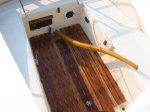- Joined
- May 2, 2009
- Messages
- 7
Does anyone have any experience with using hardwood flooring as a boat deck? I'm considering a wood deck for the 1967 Larson 14' boat that I'm working on. I have enough 2.5" x 3/4" tongue and groove oak hardwood flooring left over from installing the floor in the house a few years ago to cover about half of the boat, so I'm tempted to use this in order to minimize costs.
I know it would be necessary to seal the underside and edges of the planks with (epoxy?). In houses, the hardwood is nailed to a 3/4" plywood subfloor. To minimize weight, I was considering using a 1/4" plywood "subdeck" covered with fiberglass cloth for strength, and coating the underside, tongue, and groove of each plank with epoxy as I laid the deck, so that epoxy, rather than nails, would be responsible for securing the deck to the underlying plywood. Any thoughts on this approach?
For a non-slip surface, I've thought of two options:
A.) applying a non-slip texturized clearcoat - I'm unsure if this would work because the hardwood flooring is prefinished with a baked on factory clearcoat. Would a second clearcoat adhere well to the pre-existing one? Would coarse-grit sanding be required first? Also, I don't know what the best clear texturizing agent would be. I've considered silica for this. Any thoughts?
B.) using caulk or rubber between the tongue and grooves - I don't know how structurally detrimental this would be - would the epoxy still be enough to hold it together? I have no clue what kind of product to use for this. Also, I don't know if the top of the planks (prefinished from factory) would require additional sealing? If so, should this be done (I'm assuming) before applying the rubber between planks (i.e. seal each plank, one at a time) OR should it be done after the deck is completely installed (i.e. seal top of planks, rubber, and everything all at once) - the latter seems that it would reduce or eliminate the non-slip property of the rubber. Clearly, this option is the less developed of the two
Some interesting (though more expensive) alternative options for wood decking are shown on this website. There's also some general information on wood that may be of interest:
http://www.worldpanel.com/FAQ.htm
Thanks for reading my long post; I look forward to everyone's comments!!
I know it would be necessary to seal the underside and edges of the planks with (epoxy?). In houses, the hardwood is nailed to a 3/4" plywood subfloor. To minimize weight, I was considering using a 1/4" plywood "subdeck" covered with fiberglass cloth for strength, and coating the underside, tongue, and groove of each plank with epoxy as I laid the deck, so that epoxy, rather than nails, would be responsible for securing the deck to the underlying plywood. Any thoughts on this approach?
For a non-slip surface, I've thought of two options:
A.) applying a non-slip texturized clearcoat - I'm unsure if this would work because the hardwood flooring is prefinished with a baked on factory clearcoat. Would a second clearcoat adhere well to the pre-existing one? Would coarse-grit sanding be required first? Also, I don't know what the best clear texturizing agent would be. I've considered silica for this. Any thoughts?
B.) using caulk or rubber between the tongue and grooves - I don't know how structurally detrimental this would be - would the epoxy still be enough to hold it together? I have no clue what kind of product to use for this. Also, I don't know if the top of the planks (prefinished from factory) would require additional sealing? If so, should this be done (I'm assuming) before applying the rubber between planks (i.e. seal each plank, one at a time) OR should it be done after the deck is completely installed (i.e. seal top of planks, rubber, and everything all at once) - the latter seems that it would reduce or eliminate the non-slip property of the rubber. Clearly, this option is the less developed of the two
Some interesting (though more expensive) alternative options for wood decking are shown on this website. There's also some general information on wood that may be of interest:
http://www.worldpanel.com/FAQ.htm
Thanks for reading my long post; I look forward to everyone's comments!!




















